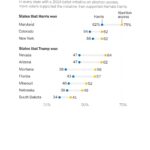The presidential election of Nov 5, 2024 came as a bitter disappointment to those fearing a second Trump administration. Part of the concern was the supposition that bodily autonomy would be further alienated by an overreaching government. In fact, if one looks past the top line numbers of Trump vs Harris, the clarion message was that bodily autonomy trumped party allegiance by a country mile.
Let us examine what has happened state by state since the Dobbs v Jackson Women's Health Organization decision on the last day of the 2022 term. Since then in all seven states where measures on abortion have been on the ballot, the vote was decisviely in favor of maintaining, if not expanding, abortion rights by enshrining such a right into the constitution, or conversely defeating a measure to prohibit or limit abortions ( California, Kansas, Kentucky, Michigan, Montana and Vermont in 2022 and Ohio in 2023). It is noteworthy that of the seven states, Kansas, Kentucky, Montana and Ohio are deep red states where Donald Trump would easily prevail in the Nov 2024 election. Blue states were equally quick to vote such protections; New York, Oregon and New Jersey had earlier enshrined reproductive right freedoms in their constitutions.
On election night 2024, there were ballot measures in 10 states on the issue of amending the state constitution to protect (or alienate) the right to an abortion. Such measures were approved in seven (Arizona, Colorado, Maryland, Missouri, Montana, Nevada and New York). The proposal in Flordia to add a right to abortion failed to meet the 60% threshold for a constutional amendment, but was approved by 57%. In Nebraska, the Right to Abortion Initiative was voted down by the narrow margin of 51.2% to 48.8% (22,004 votes out of 913,866 cast) while a competing Voter Inittiaive to ban abortions after the first trimester passed 55% to 45%). A vote to amend South Dakota's draconian prohibition on all abortions failed 58.59% to 41.41%.

In total,voter intiatives on abortion have been approved in 14 of the 17 times when the voters, instead of their elected officials, were allowed to opine on the topic.
What does this have to do with the Right to Die?
First it establishes that people's view about bodily autonomy transcends party affiliation. In blue states, where abortion rights were up for a vote, reprodutive freedom outpolled Harris consitenlty. In red states which voted for Trump, in most cases a majority of voters supported amending the constitution to protect bodily autonomy.
One has to consider the issue at hand. Abortion will always be a divisive issue. For every person who feels the woman's right to decide is absolute, others will counter that at some point the embryo which evolves into a fetus and which increasingly resembles a baby must have its rights as well considered. In other words, there is a dichotomy which both sides have to recognise and respect. There will be competing interests between the wishes of the woman who is bearing the child in a body over which she has autonomy and the developing human being for whom some regard must be made.
Such a dichotomy does not exist in the Assisted Dying movement. Whatever concerns about the innocent fetus/baby which inflame the pro-life movement are simply absent when a mentally competent, terminally ill adult makes a rational and considered decision that they no longer wish to linger futilely in existential angst and physical agony. Consider the overwhelming votes in favor of abortion rights even in deep red conservative states? Is there any doubt that in comparison with the complexity of abortion, the case for assisted dying is self explanatory?
Now, there was indeed a vote this past Nov 5 to enshrine a constitutional ban on assisted dying in by far the reddest (and presumably the most morally conservative) state in the country. In West Virginia, Trump had his highest percentage of the popular vote 70%, and Governor Justice won the vacant seat of Senator Joe Mancin with 69% to his Dem opponent's 28%. Although West Virginia already prohibits assisted dying and euthanasia by statute, MAID opponents were eager to enshrine the ban in the state constitution. A fierece campaign ensued with opponents spreading lies about the risks and the vulnerabilities of a procedure which has provided relief to tens of thousands of Americans in the 25 years when such laws have been available without a single documented case of a wrongful death. The final vote in this most conservative state- an approval by 50.5 to 49.5%. The measure succeeded by a total of 6,080 votes out of 665,564 cast.
Consider then the implications of the most conservaitve reddest state in the country which voted overwhelmingly for Donald Trump, where party allegiance is de rigeur. Consider the way the MAID opponents sought to scare the electorate with elaborate strawmen and irrational fears. Even then, despite the millions of dollars which MAID opponents poured into the effort, people realised it was their own choice, their own autonomy at stake, and the government has no business interfering.
The opponents may have breathed a sigh of relief that the measure passed by a whisker, but the reality is it was at best a Pyrrhic victory for MAID opponents and a moral victory for MAID's advocates who "beat the spread".
Opponents of MAID should take notice that even in the reddest state in the country, with the most loyal Republican base, a measure to ban MAID passed by the slimmest of majorities. People want bodily autonomy; they have made that clear in the many voter initiatives on abortion. We can consider the case of West Virginia's vote to further ban Assisted Dying, proof not of the public's rejection of MAID; but to the contrary evidence that the tide of history is in favor of expanding access to end-of-life procedures which conform to an individual's narrative.


